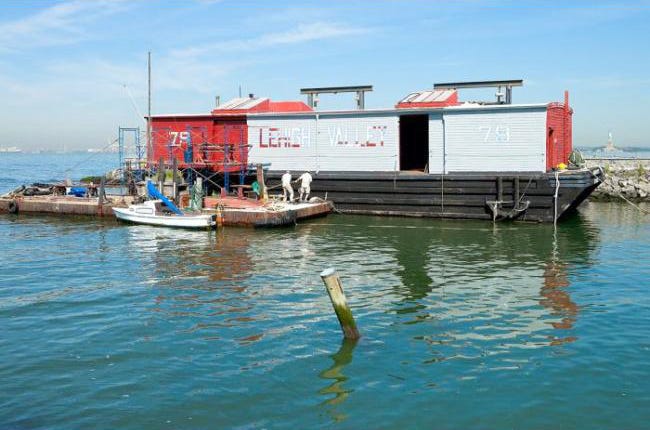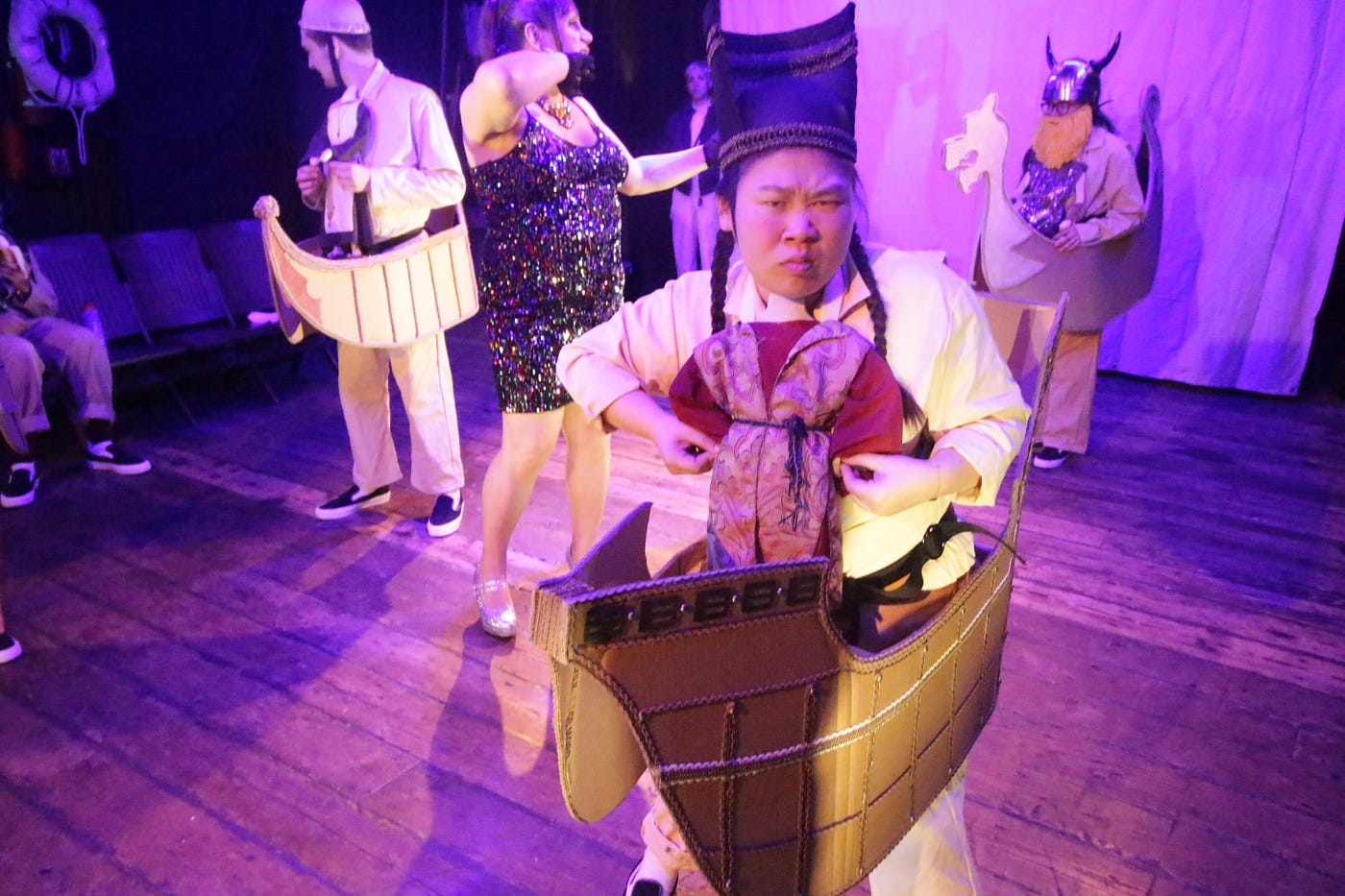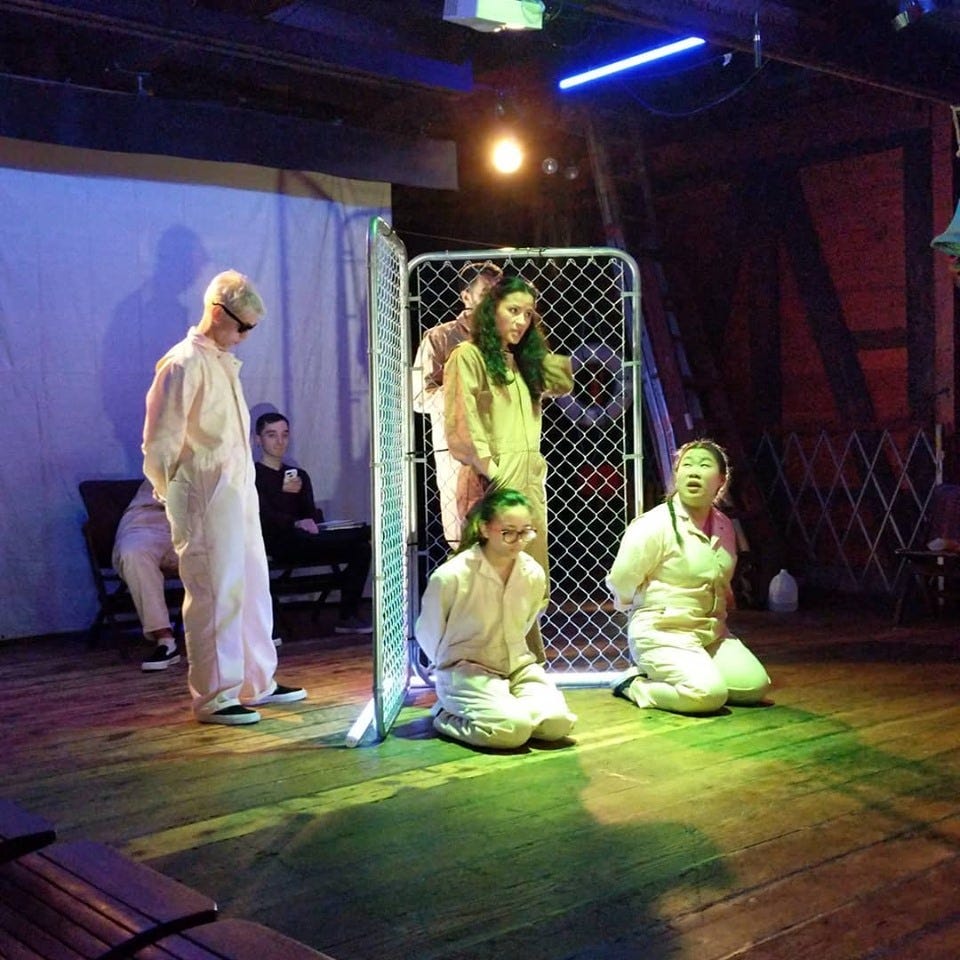
The Pier 44 Waterfront Garden located in Red Hook, Brooklyn gifts you with a jaw-dropping view of the Statue of Liberty. She is so close that I feel like I could just reach out and touch her. Adjacent to the Garden, bobbing lazily next to the pier, is also a century-old wooden barge. Once called “Lehigh Valley Railroad Barge #79,” this now obsolete cargo ship is not only the permanent home to the Waterfront Museum but also the location for Falconworks Theater Company’s site-specific production of I Migration.

While drinking in the sight of the Statue of Liberty and waiting for the house, er, barge, to open, I am approached by a performer, Yadira De La Riva, dressed in skin-toned long sleeves and a full pant jumpsuit. Holding a clipboard, she asks if I would like to be a special part of the performance tonight. Without thinking twice, I agree and promptly sign the waiver. She thanks me and quickly disappears into the yawning open mouth of the Waterfront Museum.
Soon after, we are given permission to board the barge via a ramp. Taking a small step down and into the dimly lit space, the belly of #79 is slightly smaller than her bloated exterior. In shadows on my right, I see a dimly lit kitchen, but on my left, a blue light spills onto a tarp with wooden benches are intimately placed around it. I am directed by Yadira to make myself comfortable on benches closest to the tarp.
The performance being with a warm-up exercise to create a safe and collaborative space. As an audience, we work together to create an environmental soundtrack through making noises. It’s very well executed but the need for an audience-created soundscape never appears again in the two-hour long performance. We are also warned multiple times during the beginning that there will be an evacuation scene in the piece, but that we should not be alarmed when this occurs. However, this scene ends up taking place within the first ten minutes of the show; it consists of flashing lights, a blaring alarm, and the actors moving benches from the front of the space into the sides of the space, creating a less intimate environment and a more “in the round” atmosphere. The furniture rearranging, unfortunately, felt unneeded. The benches could have simply begun in a wider formation from the start of the show rather than using up important on-boarding time and giving so much emphasis to something that ultimately didn’t matter.

The show begins in earnest after this. The first few scenes of I Migration cotain poetic writing from Reg Flowers that floats over the cast as they dance through the mythology of humankind, taking us from the dawn of time to the ultimate large scale scattering of man across geographies. Vassilea Terzaki performs a mesmerizing movement piece, choreographed by Thaddaeus Abbott, concerning the inception of war and violence. The reverberating breath of Terzaki paired with animalistic movement holds the audience in wonder. We also witness a Native American smoke cleansing: a lighter held to a tuft of dried herbs, burning in front of us.
Get Michaela Ternasky-Holland’s stories in your inbox
Join Medium for free to get updates from this writer.
SubscribeSubscribe
Each cast member performs a small piece about their personal experiences with migration as a projector behind them flashes pieces of text. I also appreciated that some actors and actresses in I Migration performed parts, or even the full length, of their narratives in their native tongues without any interpretation provided for the audience. These stories ranged from an immigrant father turning his back on the symbols of his religion in order to assimilate (as told by Jayraj Gill) to a heavy-hitting spoken word piece about the challenges of being adopted from China by a Caucasian mother (as told by Lily Randall). It was thrilling to see and hear a diverse cast being allowed to fully embrace all aspects of their own heritage, pilgrimage, and “American-age.” (Yes, I am claiming that is a word).

The rocking of the barge and the incessant creaks of its old planks gave a certain amount of weight to I Migration, but never once did the performance actually take us into the belly of the ship. There was a small mention of slaves crossing the seas in chains, but the retelling of their journey took place on the deck of the ship via a single monologue. The performance failed to touch upon the horrors, kindness, or survival that has happened and continues to happen for those who are smuggled or forced into immigration, topics which would have been even more poignant due to the dimly lit, creaky railroad barge where I Migration took place. I am still not sure if this is a missed opportunity or a respectful choice of the writers and creators. But at the end of the day, the barge could have easily been replaced by any other performance space.
It also turns out the participation waiver I had signed at the start was all for not, as the audience was only called upon to act out small scenes. I read title cards as a German child in an archaic pageant, written by Marion Kennedy and Katherine Isabel Bemis in 1928. I was pulled briefly on stage to become a protestor at the Mexican-American border chanting a phrase in Spanish about resistance and resilience. But that was the extent of my participation in the work.
I Migration is a mosaic of stories, one that feels robust with multiple smooth and rough edges. The potential for transporting the audience to another time or another place using the venue of the barge is never integrated into the piece. The audience participation is heartfelt, but never quite earned. The stories in the play are passionately portrayed. But I can’t help wonder about the possibilities of Falconworks Theater Company using the ship as a truly integrated starting point for the mythology of mankind and then turning the “evacuation” scene into one that disperses the audience and cast out of the barge and into the surrounding garden and the pier, leaving new sections of the area for audience members to explore. I would have loved to feel the full force of these highly personal immigration stories against the backdrop of the Statue of Liberty, instead of what we got: an assembly line of scenes where the whole never felt more than the sum of its parts.
I MIGRATION has completed its run. Learn more about Falconworks Theater Company.
NoPro is a labor of love made possible by our generous Patreon backers. Join them today!
In addition to the No Proscenium web site, our podcast, and our newsletters, you can find NoPro on Twitter, Facebook, YouTube, Instagram, in the Facebook community Everything Immersive, and on our Slack forum.
Office facilities provided by Thymele Arts, in Los Angeles, CA.




















Discussion